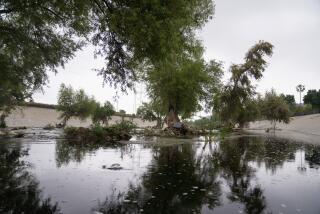Environment : A Way of Life Drifts Away Along Canada’s Gatineau : Quebec’s river log drivers, known as <i> draveurs</i> , will soon be out of work. Recycling has made them obsolete.
- Share via
LOW, Canada — In the American West, it was the cowboy who served as the long-lasting pillar of legend: A popular faith in his grit, resourcefulness and rugged individualism lived on long after the open range was fenced off into farms and the “cowboy” found himself, likely as not, behind the wheel of a Ford pickup, tending to chores on a feedlot.
In New England, it was the seafarer, in Appalachia the wily moonshiner--any number of regions have their heroes, their incarnations of the local ideal, the archetypes who have eventually been displaced by progress.
Here in Quebec, it’s the draveurs .
A draveur is a river log driver, a slightly larger-than-life backwoodsman who shepherds felled logs downriver to the pulp mills. Even in an age of advanced forest management, when engineers turn out reports on the aerodynamics of lumber trucks, draveurs can still be found on the rivers of a summer’s day here, stepping nimbly atop log booms in spiked boots, prodding hundreds of thousands of dollars’ worth of wood downstream with 10-foot pikes.
So celebrated are river drives in Canadian folklore that the Canadian dollar bill used to depict booms of logs being towed down the Ottawa River, just out of sight of Parliament. There are folk songs about draveurs, and a hoary landmark of Quebec literature--the novel “Menaud, Maitre-Draveur”--tells of an elderly Francophone draveur appalled by his daughter’s flirtations with a nasty piece of work who sells out to the English-speaking timber barons.
“If you talk about our country here, we’ve got no mines, no big factories, nothing but wood,” says Maurice Mantha, a 45-year river veteran who now supervises the 225-mile drive on the Gatineau River. “The river drive is one of the things that opened up our country. It’s a big story of the past-- l’histoire de notre passe, we say in French.”
Today the Canadian bank note with its river-drive engraving is gone, replaced by a coin that Elizabeth II shares with a loon. And few expect the draveur to last much longer. The drive on the Ottawa River ended three years ago, and the one here on the Gatineau is in its final summer. The last log drive in neighboring Ontario is also winding down this year.
There are a few remaining drives in Quebec, but the informed guess is that draveurs won’t survive as an occupation past the year 2000. Their nemesis: paper recycling.
“Right now, you can’t hardly sell a stick of pulpwood,” complains Oliver Picard, a draveur who has stopped for morning coffee in a Low diner whose walls are hung with painted sawmill blades. The smell of cut wood clogs the air; there is a sawmill just across the street. “I blame a lot of this on recycling,” he says.
In his plaid shirt and orange hard hat, Picard looks very much the part of the draveur. He has been working the Gatineau for 33 years, knows its bends and shoals, has his favorite seasons and skiffs. He has pulled half a dozen suicides from the river over the years and tells of two fellow draveurs who were swept to their deaths over the dam’s spillway at Low. Picard started out as a lowly “flumer,” a man who guides logs through a flume, bypassing the dam. Over the years, he has worked his way up to foreman on a 20-mile stretch of river. His two sons are both draveurs.
Last month, Picard’s employer, Canadian Pacific Forest Products Ltd., told him that he, his crew and all the other draveurs of the Gatineau would be replaced by a fleet of trucks. Canadian Pacific offered the older draveurs retirement benefits and promised the younger ones lessons on writing resumes and handling job interviews.
At 53, Picard isn’t sure which group he falls into. He has avoided finding out.
“The company didn’t give me any notice yet if I’m finished, or when I’m finished,” he says. “Most of the guys feel let down. I guess they figured they were going to be there for a lifetime’s work. Now it looks pretty grim.”
No wonder the draveurs expected a life of work on the water: Here in the Gatineau Valley, and along other water systems of rural Quebec, jobs on the river have been passed down, father to son, for generations. It wasn’t all that long ago that for young male Quebecois the first winter spent in “the bush” was a rite of passage.
In the folklore of this woodsy and picturesque region, the draveur was a hardy breed, undeterred by brutal winters, bad food, mean bosses, hungry blackflies, white water or the hazards that come with dynamiting logjams sky-high. In the early 1800s, when river driving got its start, odds were that he was an impoverished, French-speaking farm boy, recruited by an Anglo-owned timber company.
Every winter, troops of newly recruited loggers would travel by foot or horse-drawn sled to the lumber camps, where they would live until spring, cutting trees and piling the logs near streams. The English word “shanty” is, in fact, a corruption of the French-Canadian word chantier , for lumber camp.
There were no trucks to haul the logs from the stump to the riverbank then, so the men built little dams above their creek-side log piles. Come spring, they would open the dams and flush the logs as best they could down the creek beds and out into the rivers of the region.
The logs in those days were huge. The draveurs would tie them together in rafts and travel downstream aboard them for hundreds of miles, Huck-Finn-style. Every time they came to a rapids, they would have to break down the rafts and shoot the logs through. They would portage all their food and gear around the white water and then catch the logs and reassemble the rafts on the other side.
It was slow, difficult and supremely dangerous work, and the pay was insulting. A man who lost his footing and fell in with the logs in fast water could be crushed.
But the worst danger came from the logjams that could form on the shallows. Logs would become fouled on the rocks or on the bottom, and as the current pushed down new logs on top of them, the knot would grow and grow. Even today, some jams take weeks to break up.
The early draveurs would risk life and limb by walking out onto the jams, prying them apart with their peaveys--wooden staffs with hooks. Men who succeeded in extricating key logs had to jump quickly to keep the jam from rumbling down on top of them . As one Canadian folk song goes:
They had not rolled off many logs when they heard his clear voice say,
“I’ll have you boys be on your guard for the jam will soon give way.”
These words were scarcely spoken when the jam did break and go.
It carried off those six brave boys and their foreman, young Munroe.
The toughest jams of all were blasted apart by dynamite -- a tremendous hazard in the days before primer cords were perfected and multiple charges could be set off simultaneously. Early draveurs had to clamber over the jams in teams, everybody lighting his own fuse and scrambling away, hoping no one else had lighted his too early. Today, draveurs use less dynamite and safer fuses -- when they have to use dynamite at all. Today there are chain saws to cut through jammed logs and sturdy skiffs fitted with winches to pull logs apart before resorting to explosives.
The draveur’s work has been simplified in other ways. Trucks and other machines have penetrated the forests, so loggers don’t need to rely on tiny creeks to get logs into the river. Winches have reduced crew sizes and the constant need for peaveys. Today, Picard and his men can commute to their work in the morning and be home by nightfall. No one gets a whole summer on a raft anymore.
Still, the generations-old mystique of the river drive endures. “It was more than just a job, eh?” says Picard, standing on the open bow of one of his small fleet of skiffs as his boat operator pilots upstream between hilly, tree-lined shores. Canada geese skip along with water’s surface; a rare blue heron arcs silently overhead.
“The river itself is a beautiful river,” he adds. “I’ve traveled on other rivers, like the Ottawa, but I’ve always preferred the Gatineau. Especially in the fall. Come October, it’s just like a picture, eh? The leaves are turning and it’s beautiful.”
Change may have made a day’s work easier for Quebec’s draveurs, but it is change that is also sending them into oblivion. The major change is recycling.
“Some U.S. states are insisting that by 1994, any newsprint must contain a certain content of recycled paper,” says Ken Allan, Canadian Pacific’s woods manager in Maniwaki, Quebec, about 45 miles upstream from where Picard is working. “More and more are getting on board, to get rid of some of the landfills . . . . Some states are going as high as 40 % recycled content.”
A bill recently passed by the U.S. House of Representatives would require all newspapers with circulations of 200,000 or more to use newsprint containing 50 % recycled paper or better.
To meet this growing demand, Canadian Pacific installed a de-inker at its Gatineau pulp mill this year; now the mill now can make pulp from a 60-40 combination of virgin wood and recycled newsprint.
But that, Allan says, reduced the size of the river drive by 40%--and suddenly made it uneconomical.
While a river might appear at first glance to be a free source of power, driving logs is surprisingly expensive. There are the draveurs to pay. There are boats and booms to finance and maintain. There are the logs that inevitably sink during the drive, sinking revenues as well.
“There’s a lot of hidden costs in transporting logs by a river,” says Tony Sauder of the Forest Engineering Research Institute of Canada.
To make matters worse for the draveurs, people who own vacation property along the rivers of this scenic region have grown increasingly grumpy about having to share the waters with millions of logs.
And lately the draveurs have even been taking flak from environmentalists, who allege that the decaying sunken logs they leave behind are greedily consuming the rivers’ oxygen, leaving the fish to suffocate. Indeed, there are stretches of the Gatineau where the logs are several feet thick on the bottom and the water smells richly of bark.
“It’s unfortunate (to end the river drive) because it’s an authentically Canadian enterprise, but it is hard on the river system,” Sauder says.
This month, the draveurs of the Gatineau are working on “the sweep”: rounding up decades’ worth of stray logs from the bays and sloughs along the riverbanks and prying up deadheads from the bottom. When they’ve prodded the last log out of the backwaters and sent it on down to the mill, they’ll go home, and their occupation will continue in legend only.
“It makes me sad to see its passing,” Allan says. “It’s a way of life we’ll never see again.”
More to Read
Sign up for Essential California
The most important California stories and recommendations in your inbox every morning.
You may occasionally receive promotional content from the Los Angeles Times.













